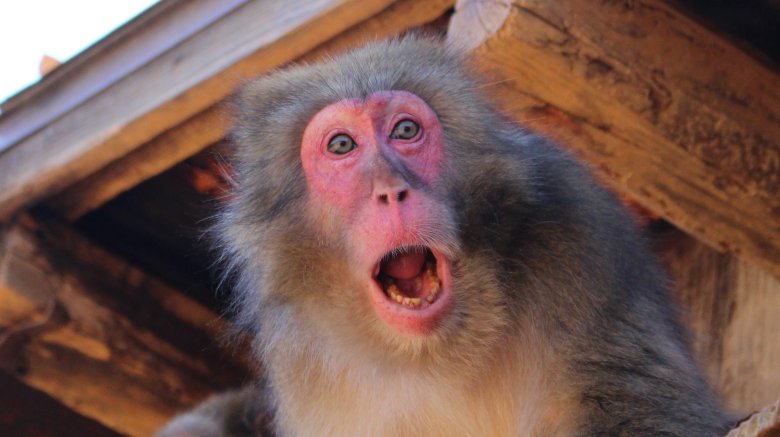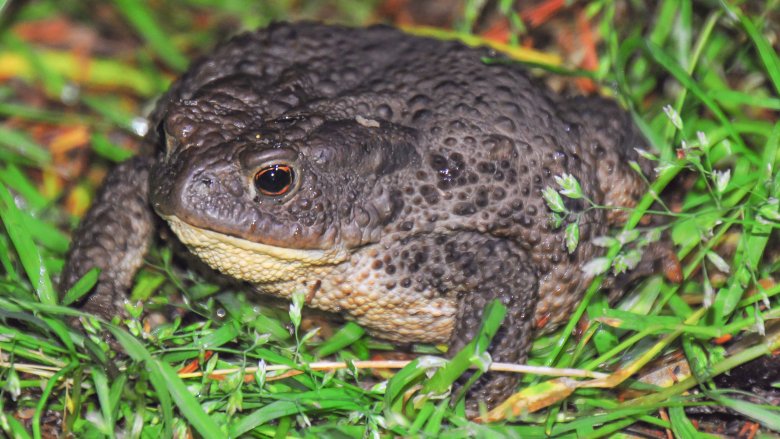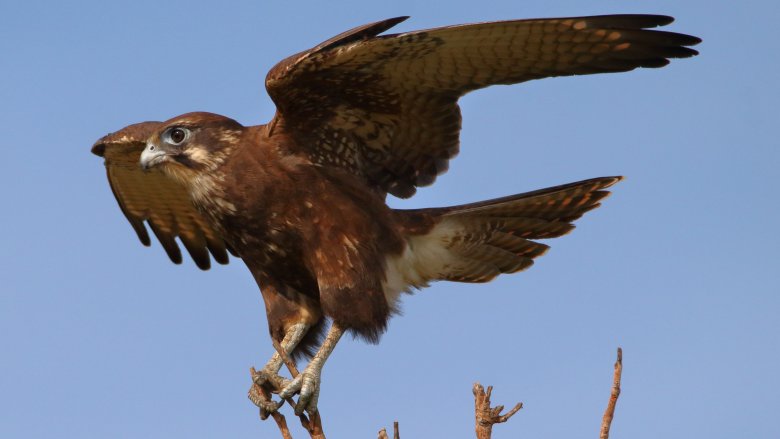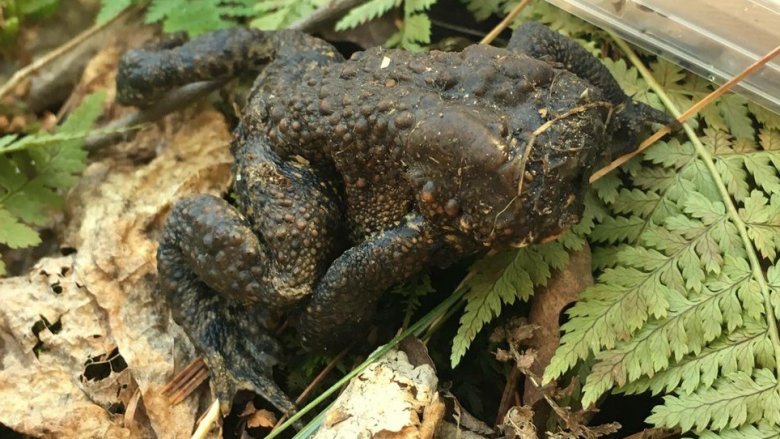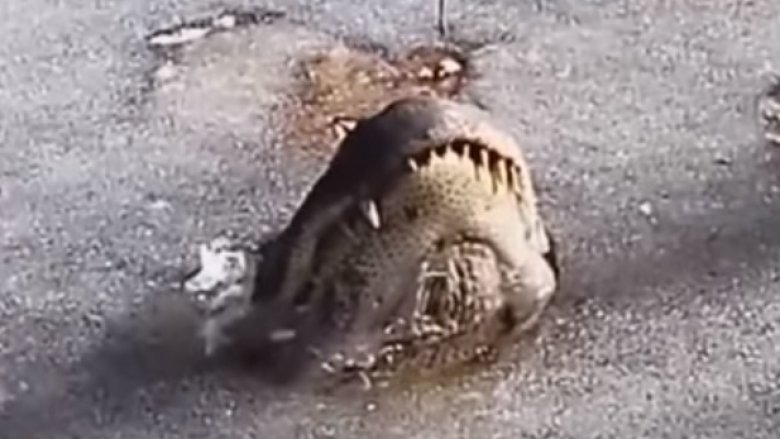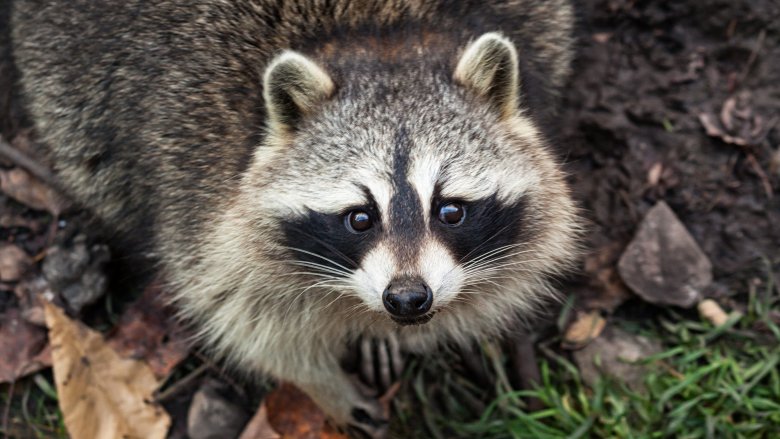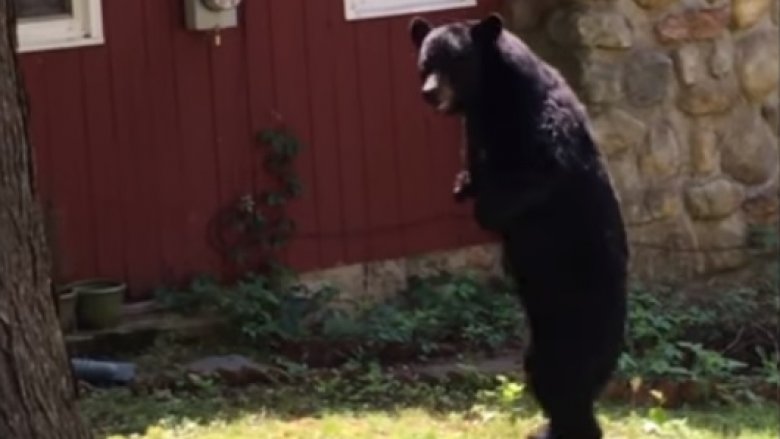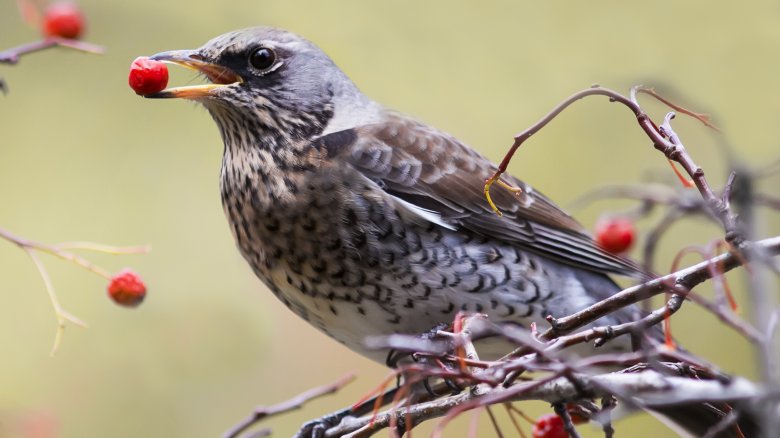That Time A Snake Wore A Decapitated Fish Head Plus 9 Other Bizarro Animal Moments
In 1856 Charles Darwin penned a letter to his pal J.D. Hooker, whom he affectionately addressed as "My dear Hooker." In that message the revolutionary behind evolutionary theory touched on the question of whether jellyfish take in sperm orally. He then darkly remarked, "What a book a Devil's chaplain might write on the clumsy, wasteful, blundering low & horridly cruel works of nature!"
Clearly, Darwin needed to vent to his dear Hooker about the weirdness he witnessed in the wild. Nature had filled his head with thoughts of jellyfish drinking baby-making juice and probably exposed him to the kinds of deaths that would give serial killers nightmares. Such scenes must have been extra shocking back in his day because Darwin didn't have the Discovery Channel to warn him about what he might see. But even now in the age of Shark Week, Mother Nature comes up with scenarios strange enough to give our heebie-jeebies a case of the willies. Here are 10 bizarro animal moments that feel like examples of unnatural selection.
Germany's toads explode like gory balloons
Toads are big, lumpy warts that use mushrooms as stools for some reason. Or maybe they poop toadstools. We're not really sure because we aren't toad-ologists. Nevertheless, we can say with certainty that toads aren't supposed to pop like gory balloons in the dead of night. Yet in northern Germany that's precisely what happened in 2005.
As the BBC detailed, an epidemic of toad explosions rocked Hamburg's Altona district. Thousands of them expanded to more than three times their normal size and then went kablooey, spraying amphibian innards all over the place. The force of each blast could launch toad guts as far as 3 feet. Scientists were left scratching their heads. Was a fungus or a virus to blame? Were croakers being rigged with explosives? Adding to the urgency of the situation, toads were also bursting in Denmark, indicating that the problem might have spread.
Experts eventually arrived at an explanation that revealed how truly sadistic nature can be. Apparently clever crows were ripping out and eating the amphibians' livers. Why the flaming hell would they do that? Turns out the toads were toxic for the most part, but crows, being amazingly smart animals, figured out how to locate the nontoxic parts with surgical precision. The toads puff up as a defense mechanism, but their livers keep the puffery to reasonable levels. Without them ... kaboom!
Australia's flying arsonists
Just as Smokey the Bear reminds Americans not to set forests alight, Bushy the wallaby teaches Australian children about bushfires. Unfortunately, Australia also has pyromaniacal raptors that are every bit as cunning as the velociraptors in Jurassic Park. Obviously, the raptors Down Under aren't dinosaurs; they're birds, which are widely believed to have evolved from dinosaurs. Only they're worse than their prehistoric ancestors because they figured out how to weaponize bushfires by intentionally spreading them.
According to Live Science, the aerial arsonists in question come in three varieties: brown falcons, black kites, and whistling kites. Known as fire foragers, these particular birds wait at the outer boundaries of wildfires so they can pick off fleeing animals. Because everything's deadlier in Australia, these hunters scare even more animals out of hiding by picking up smoldering grass blades and twigs and dropping them in previously unburned areas.
Claiming that untrained animals strategically set wildfires in order to prey on would-be escapees might sound like irrational paranoia about the lethal insects and brutal beasts that make Australia the bustling murder-scape we all know and fear. But Aboriginal people have known about the bird arson since forever, and scientists have observed it since at least the 1960s.
The mystery of the 'smoking' elephant
Generally speaking, anyone who says they saw a random animal smoking in the woods probably "saw" it while smoking something themselves. But recreational chemicals can't explain the footage recorded in India's Nagarhole forest in 2016. Per the BBC, a wild elephant was caught on film blowing ashes off charcoal after a wildfire. As conservation scientist Vinay Kuma recounted, it "almost appeared as though the elephant was smoking."
Since cameras don't get high, the recording presented a legitimate mystery. No other known footage exists of a wild elephant impersonating Joe Camel, and experts were utterly flummoxed by the whole thing. Was the elephant just pulling random behaviors out of its trunk, or did the puffing actually have a purpose? Nobody really knows, but elephant biologist Varun R. Goswami theorized the elephant intended to eat the charcoal, which has medicinal properties and can also serve as a laxative. In other words that video might have shown a constipated pachyderm attempting to break up the logjam in its bowels.
The toad without a face
Remember when Kermit the frog's face got ruined in a terrible accident at the Macy's Thanksgiving Day Parade? If you imagine that story as a horror movie about a real amphibian and crank up the creepiness to 11, the result still won't be nearly as eerie as what herpetologist Jill Fleming experienced in 2016.
As Live Science described, Fleming was in a Connecticut forest researching newts. What she didn't see was the eyeless, nose-less, tongue-less creature about to greet her. When she sat on a log to analyze her findings, a toad bumped into her feet and other things. When the collisions kept happening, it soon became clear that the animal wasn't just clumsy or saying hello.
It was probably saying "Help me," because the toad had a "stump covered by smooth tissue" and a tiny mouth hole where its face should have been. Fleming spent more than a year wondering how such a thing was possible and presumably screamed in her sleep each night before finally consulting Twitter for answers. A veterinary expert suggested that flesh-eating toad fly larvae feasted on the poor animal as it hibernated, and its otherwise healthy body hadn't yet succumbed to malnutrition. Alternatively, perhaps a predator ate its face.
When smell freezes over
We tend to think of alligators as cold-blooded killers, but that's super ironic because when their blood actually gets cold they slow down, making it harder for them to kill anything. Plus, "cold-blooded" is kind of a misnomer. Really, alligators and other creatures that can't create heat internally are poikilothermic, meaning they're only as cold as the ambient temperature. Admittedly, "poikilothermic killer" doesn't quite capture how bone-chilling alligators are. Heck, if you saw a bunch of them frozen like ice cubes the sight might frighten you to death. Just look at the ones in North Carolina.
Or don't look at them because they're creepy as crap. The worst part is the gators were submerged in a frozen pond, save for their snouts, making it appear as though carnivorous tumors grew in the water. Wait, no, the worst part is that the reptiles posed this way on purpose, according to the Charlotte Observer. That's how they survive sudden extreme drops in water temperature.
In 2018 a "bomb cyclone" storm turned parts of North Carolina into an ice box, so gators at Shallotte River Swamp Park poked their noses out of a pond and allowed themselves to freeze in place. They can probably stay in that light hibernation state for a week before their cold blood kills them, so the icy reptiles were just fine.
'Zombie' raccoons invade Ohio
What's not to love about raccoons aside from the scary parasites they carry, those aggressively beady eyes that radiate ill intent, and the fact that they raid your trash can and leave an absolute mess that you have to clean up in the morning? Well, if you live in Youngstown, Ohio, you might not have loved it when raccoons started acting like furry versions of the undead.
In 2018 Youngstown police fielded over a dozen calls about unsettling raccoon encounters. Resident Robert Coggeshall described one such run-in to WKBN. A seemingly entranced raccoon "would stand up on his hind legs, which I've never seen a raccoon do before," Coggeshall recalled, "and he would show his teeth and then he would fall over backward and go into almost a comatose condition." Attempts to shoo away the animal failed as the raccoon repeatedly fell in and out of its stupor and eventually followed Coggeshall to his door.
The uncomfortable incidents were made even more jarring by the fact that they mostly happened in broad daylight despite the fact that raccoons are nocturnal. Obviously, this was a job for science. Health officials quickly ruled out the possibility of zombies. In reality, the raccoons had distemper, a nasty neurological malady that spreads virally and mimics the symptoms of rabies.
The circle of death
Turkeys have a habit of terrorizing towns in what can only be interpreted as a concerted effort to punish mankind for Thanksgiving. In 2016 gaggles of gobblers chased and occasionally cornered people in New Jersey. In 2018 they engaged in shenanigans again in Massachusetts. Thankfully, on this go-round their antics weren't violent, just ridiculously morbid.
Residents of Randolph, Massachusetts, viewed an unnerving nature video, courtesy of one Jonathan Davis. A group of roughly 30 turkeys circled a dead cat in the street, which Davis characterized as "a ritual." Some viewers believed the birds wanted to resurrect the feline. Turkey expert David Scarpitti told Boston Magazine, "It's not something that's really ever been documented until today," but he promised the birds weren't dabbling in voodoo.
Turkeys fear cats, so when they saw one of their dreaded adversaries die they probably got super curious. The leader likely started inspecting the corpse, and the rest followed. Biologist Richard Buchholz noted that turkeys instinctively follow each other, which might explain why the ones in Randolph walked in that disturbing circle.
Bears can be upright citizens, too
When they aren't flashing their murder fangs, bears look downright huggable. So when footage of a black bear walking through Jefferson, New Jersey, on its hind legs surfaced online in 2014, the public was abuzz. The clip racked up hundreds of thousands of views, with some speculating that the bear was injured and others dismissing the footage as fake, per the Daily Record. Sadly, Option A proved true.
The bear, whom people dubbed Pedals because he was bipedal, had injured forelimbs and adapted by walking upright. By surviving in his compromised state and looking as cuddly as furry teeth can be, Pedals became an internet celebrity. Unfortunately, he also attracted real-world trolls. Angi Metler, the director of the Bear Education and Resource Program, wanted to place Pedals in a sanctuary because "hunters were gunning for him."
Metler's fears were realized when a hunter killed Pedals in 2016 during one of New Jersey's first bow-and-arrow hunts in decades.
That snake's head looks really fishy
Nature owes you an apology for this one. It looks like a snake found Nemo, ate most of him, and wore his disembodied head as a macabre trophy. Either that or this is just what happens when Satan's favorite animal goes trick-or-treating. Seriously, Nature, what on Lucifer's gangrenous earth were you thinking?
We may never know the answer to that question, but herpetologist Emily Taylor told Inverse what the snake was probably thinking. "The most likely scenario is that the snake sensed the dead fish using its ability to 'smell-taste' the water or air on the surface, and is investigating to see if it could eat it," Taylor explained. Unfortunately, the snake couldn't eat the trout. That slithering sliver of nightmare fodder is too small to eat something that size, no matter how wide it tried to unhinge its horrifying jaw.
The snake didn't even bite off more than it could chew because snakes don't chew; they swallow their meals whole. In other words, what appeared to be a serpentine Buffalo Bill wearing its murder victim was just a hungry snake whose eyes were bigger than its stomach. Even worse, the snake didn't just decide to wear the head as a consolation prize; it got stuck inside while failing to eat it.
Birds get caught diving while intoxicated
Did you know that birds don't pee? In lieu of tinkling, they produce white "white paste" they like to dump on people's vehicles. But even though our feathered friends can't make urine, they can still get piss drunk like the birds in Gilbert, Minnesota.
In 2018 the weather was warm for too long and a frost arrived too early in Gilbert, according to ABC. But that may have made the climate just right for berries to ferment before birds consumed them. The result was a succession of unintended benders for young fliers whose livers weren't well-equipped for liquor. And you can probably guess what happens when a birdie throws back too many berry brews.
Blitzed birds dive-bombed cars and houses. One feathery menace crashed through a window. They recklessly weaved in and out of traffic, per the Washington Post, and one motorist claimed that two birds smacked against her windshield in one day. Another said she hit seven in a week. Inexplicably, some people called the police to ... arrest the birds? Officer Chelsea Trucano probably didn't have small enough cuffs, but she did suggest building a "detox box" for birds by cutting holes in a cardboard box. At the very least people should warn the birds not to drink and dive.
